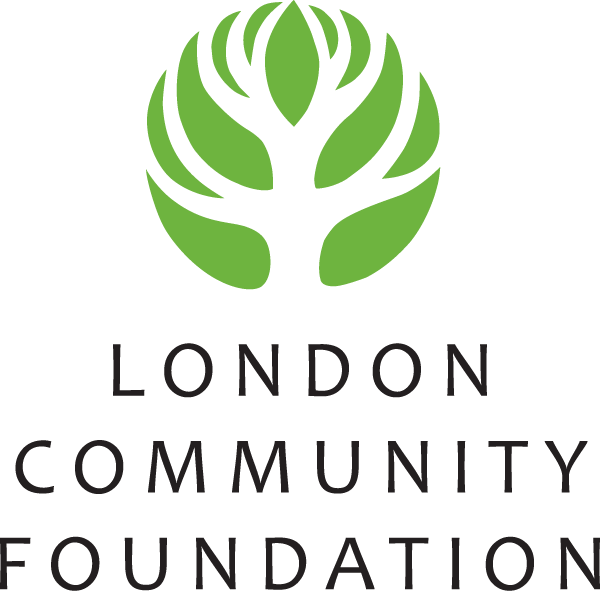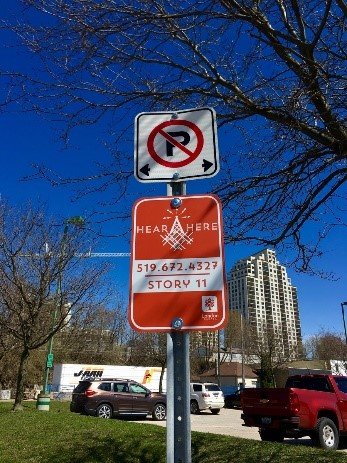Stories of SoHo
Stories of SoHo
Written by Professor Michelle Hamilton of the Public History Masters program at Western University.
Bondi's family restaurant. Vincent Jr., sits in his office top left. Courtesy of the Bondi family.
During a busy dinner time in the 1960s, customers of the iconic Bondi’s Italian Restaurant on Horton Street might find themselves seated upstairs at the family dining room with the Bondi grandparents eating their own meal. The Bondi family – Vincent and Concetta, Vincent Jr., his siblings, and his wife Pietra – immigrated from war torn Sicily in the 1950s. Concetta, who had run a bakery in Sicily, began the family business by selling homemade pizzas out of her own kitchen. Vincent Jr. then opened the famous Italian Restaurant, which he eventually expanded into a large family dining experience, with live music on the weekends, and pickup and delivery franchises as customers increased. Vincent Bondi Jr. employed many of his immigrant family members coming from Italy, to help them get started on a new life in Canada. The restaurant was family-run. As the backbone of the family and a large part of her husband's success, Pietra both tended to the home and five children during the day and worked in the kitchen at the restaurant most evenings. Vincent Jr.’s siblings helped in the early stages to build the empire. As kids, the third generation of Bondis worked there from early ages, checking coats, bussing and waiting tables, washing dishes, cooking pizzas, and learning every aspect of the business.
This is just one of the stories my students and I have heard over the past three years, since the Vision SoHo Alliance partnered with Western’s public history program to tell the stories of the SoHo neighbourhood through historical signs. Each year, I lead graduate students through a collaborative community-based historical project, and I was excited by the Alliance’s vision to adaptively reuse two of the heritage buildings, the Faculty of Medicine (1921) and the War Memorial Children’s Hospital (1922), and create new housing on the old Victoria Hospital site.
This Hear, Here signs marks a story at the original location of the African Methodist Episcopal Church on Thames Street. Courtesy of Cody Groat.
Just before Covid hit, we launched the project Hear, Here which places orange street signs in locations where Londoners can listen to stories on their cell by dialling a phone number. Over fifty signs are posted in SoHo, so I knew the neighbourhood had a fascinating history.
Since 2021, twenty-six students have researched the London General Hospital (later Victoria Hospital) and the wider history of St. David’s Ward, the area now nicknamed SoHo. As part of our research, we spoke with dozens of former residents, business owners and employees, medical and nursing students, and hospital staff and patients. One of my favourite anecdotes recounts how a mischievous med student rode a horse through the underground tunnels of the hospital, up the stairs of the medical school, and into the auditorium.
We are now drafting eight interpretative signs to be posted around the perimeter of the Alliance’s housing block, and another which will be mounted inside the old medical school auditorium. Three of the signs will interpret the architecture of the heritage buildings, medical education and innovations, patient care, and the life of students.
Two more will present daily life. Victoria Hospital employed many people. SoHo also had many factories – McClary’s Manufacturing, Hunt’s Mills, Brener Brothers’ cigars, Holeproof Hosiery, Canada Bread, London Soap, and of course Labatt – although few traces remain. Former residents described to us the smell of baking bread and yeasty beer in the neighbourhood and how, as kids, they used factory whistles to tell time.
Life was also shaped by the Thames River and by the railroads that dissected the neighbourhood. Finding fun along the river, children swam across to Chelsea Green, fished, hunted snakes, played ice hockey, and even sailed on floating chunks of ice under the Wellington Street bridge. Kids rode the London and Port Stanley railway to spend a day at the beach or daringly hopped on the back of train cars for a quick ride home from school.
Four signs focus on SoHo residents. Surveyors carved the land of St. David’s Ward from the London Township Treaty signed in 1796 by Anishnaabe groups. In the 1800s, Indigenous people from nearby Anishinaabe, Munsee-Delaware, and Haudenosaunee communities lived in the city to work, or to escape enforced government policies such as residential schooling. Community members still stayed together. In the early 1900s, John and Lucy Schulyer and their children lived in a large house on Clarence, and boarded young single men from their shared home community, Oneida Nation of the Thames. Their four sons all volunteered for the First World War. Indigenous men enlisted at a greater rate than all others during the war.
Paya-Mint, a digestive aid made from papaya enzymes and peppermint oil, once belonging to Dr. Hyman Wilensky. Papaya was also used to loosen membranes in the throat as a treatment to diptheria. Courtesy of the Medical Artifact Collection.
Unlike bigger cities, London did not have a Little Italy or a Chinatown. Instead, immigrants from different countries lived next to each other. The Londoners we talked to described the variety of ethnicities and languages of their neighbours. One woman, Jean Hough, told us about walking down Grey Street as a child, enjoying the smells of all the different traditional suppers cooking.
The earliest arrivals escaped Ireland during the potato famine in the 1840s-50s, or enslavement in the United States, often via the Underground Railroad, before slavery was abolished in the 1860s. German and Russian Jews followed because of political revolutions and religious persecution in Europe. Before the First World War broke out, poverty motivated immigration from Italy and the Middle East. Polish immigrants came in several waves, before and after the Second World War, and then out of communist Poland in the 1980s.
Prejudice made finding a job difficult. Instead, many started their own businesses. Barnet Wilensky, a Russian Jew, established a peddling business on Clarence Street. His son Hyman became one of the first Jewish doctors in the city, graduating from medical school in 1930. Not able to find a placement at Victoria Hospital due to prejudice, he interned at the Queen Alexandra Sanatorium for tuberculosis. Hyman’s daughter, Beryl, and her husband Noam Chernick also graduated from medical school in the 1960s, and become ground-breaking couples’ therapists known throughout North America.
Ad for the Ball Family Jubilee Singers. Courtesy of the Grimsby Public Library.
Community and organized religion provided a measure of resilience. In the 1840s, the Black community built a modest African Methodist Episcopal church along the river on Thames Street, a building recently rescued and restored at Fanshawe Pioneer Village. Sixty years later at its daughter church, Beth Emanuel on Grey Street, the Reverend Richard Amos Ball formed the Ball Family Jubilee Singers, and toured Canada to raise money to pay the mortgages of Black churches. Today, Our Lady of Czestochowa Catholic Church and the Polish Hall are at the centre of the Polish community.
We are partnering with the City of London on the design and installation of the signage, most of which will be along the public sidewalks surrounding the development. Once our signs are installed, we hope Alliance tenants and neighbourhood residents will pause, read, and re-read the stories of the place where they live.
Our full research report: https://www.history.uwo.ca/public_history/Soho_Jan24_fullbook.pdf
Our presentation from April 2023: https://www.youtube.com/watch?v=fHJAeTkXObk





